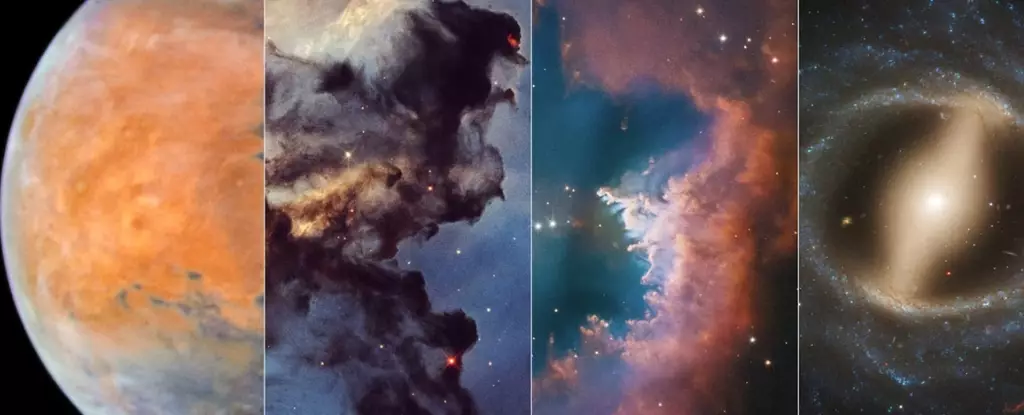This week marks a remarkable milestone in space exploration—the 35th birthday of the Hubble Space Telescope. Launched on April 24, 1990, aboard the Space Shuttle Discovery, Hubble has been nothing short of a beacon for astronomers and enthusiasts alike. Rather than simply receiving attention on its anniversary, the Hubble team has generously released a quartet of breathtaking images that showcase the vastness of the cosmos, from stunning details of Mars to captivating views of distant galaxies. This celebration is steeped in a long-standing tradition at NASA and the Space Telescope Science Institute, which takes time every anniversary to highlight Hubble’s achievements through spectacular visual data.
Historically speaking, Hubble’s early journey was fraught with challenges. Right after it was deployed into orbit, a significant flaw in its mirror threatened its mission. This initial setback only galvanized the teams at NASA and the Space Telescope Science Institute to adapt and innovate, leading to the first of many servicing missions in 1993, which greatly improved the telescope’s capabilities. This pivotal moment laid the groundwork for the revolutionary discoveries that Hubble would later contribute to the field of astronomy.
Unveiling Cosmic Wonders
Hubble’s contributions to astronomical science are monumental—over 1.7 million observations have been made, delving into approximately 55,000 targets and sparking more than 22,000 research papers. These numbers not only exemplify Hubble’s operational endurance but also illustrate how the telescope has served as an unparalleled window into the universe, reshaping how we understand cosmic phenomena. The array of images released for this anniversary provides a tantalizing glimpse into Hubble’s diverse range of studies.
One of the standout images celebrates our neighboring planet, Mars. Captured during a time when Mars was unusually close to Earth, this breathtaking view showcases the planet’s prominent Tharsis plateau, dormant volcanoes, and its icy polar cap. The clarity of these images has captivated the public, bridging the gap between complex scientific inquiry and popular fascination. This connection has played a critical role in garnering public support for ongoing space exploration initiatives.
Additionally, the rich palette of colors captured in the Rosette Nebula reveals yet another layer of Hubble’s power. This image illuminates a star-forming region located 5,200 light-years away, suffused with dark clouds of gas interspersed with illuminating dust. Such visuals not only astound viewers but also provide critical data for astrophysicists studying the lifecycle of stars and the intricate processes of cosmic formation.
Enduring Challenges and Future Directions
However, Hubble’s journey has not been devoid of obstacles. Following the tragic loss of the Space Shuttle Columbia in 2003, plans for repairs were put on hold, igniting widespread concerns about the telescope’s future. The public outcry led NASA to revise its plans, culminating in a final servicing mission in 2009 that extended Hubble’s operational life significantly. In a testament to its design and engineering, Hubble has continued to provide outstanding data for an astonishing 16 years after this mission.
Yet, as Hubble continues to age, it experiences periodic technical glitches that remind us of the finite nature of any technology. The advent of the James Webb Space Telescope (JWST), launched in 2021, introduces a new paradigm in space observation. With a capability of collecting seven times more light than Hubble, JWST enhances our understanding of the cosmos in ways Hubble could not. Positioned a million miles from Earth, JWST primarily operates in the infrared spectrum—a departure from Hubble’s diverse range of visible and ultraviolet observations.
This shift not only highlights advances in technology but also poses questions about the future of astronomical exploration and our reliance on singular technologies. As NASA considers the design and functionality of its next project, the Habitable Worlds Observatory (HWO), the lessons learned from Hubble’s legacy loom large. Planned for launch in the 2040s, HWO aims to search for Earth-like planets in distant solar systems, promising sharper and more detailed images than those provided by Hubble.
Inspiration for Generations
The Hubble Space Telescope embodies the spirit of exploration and the relentless pursuit of knowledge. Its 35-year journey not only highlights its exceptional contributions to scientific discovery but also underscores the fundamental human desire to understand the universe we inhabit. Each image, every observation, has illuminated aspects of our reality that were once shrouded in mystery, creating a rich tapestry of information that continues to inspire. As we celebrate this iconic telescope, we invite collective appreciation for the incredible journey it has taken and the myriad of discoveries that lie ahead, thanks to its foundation.


Leave a Reply